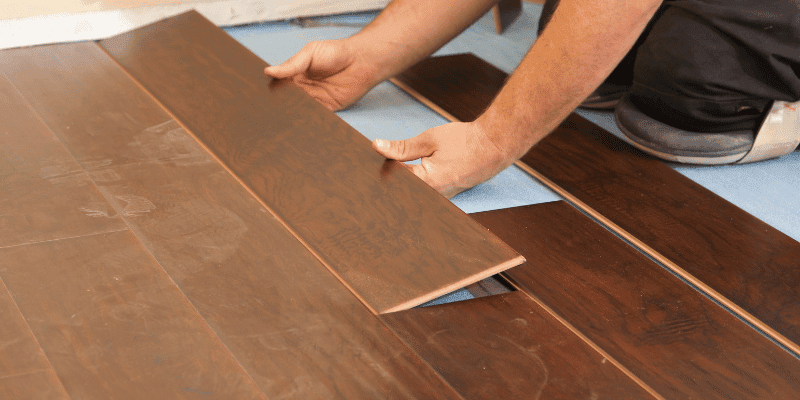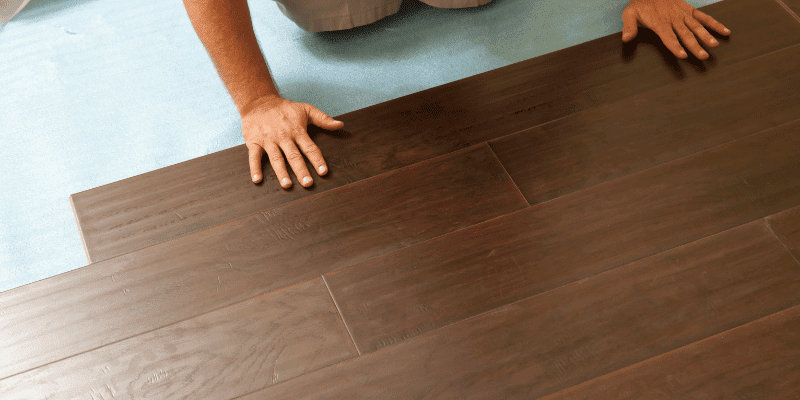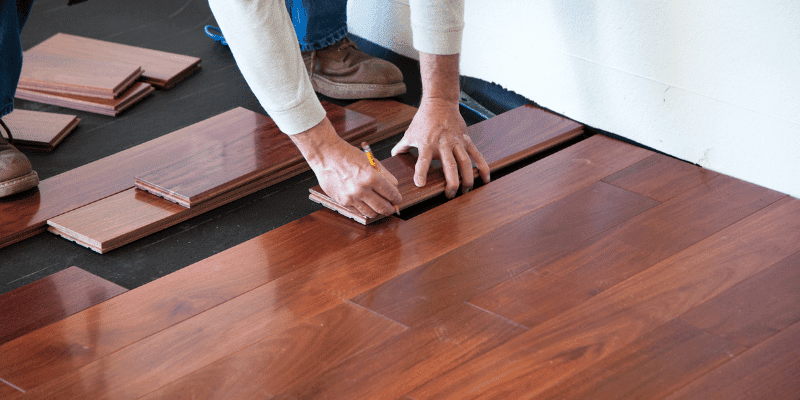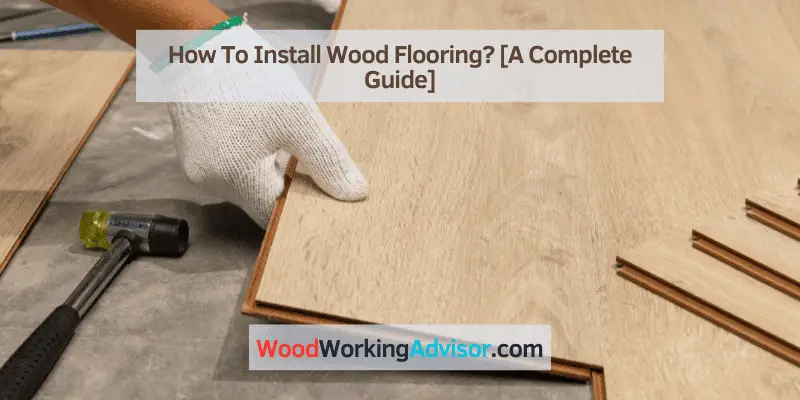Transforming your space with the timeless elegance of wood flooring is a rewarding endeavor, but it requires careful consideration and a methodical approach. Whether you’re enhancing the aesthetics of your home, planning a DIY project, or hiring professionals, the installation of wood flooring demands meticulous attention to detail.
Start with preparing the floor and acclimating the wood planks. Next, install the underfloor for support and protection. Lay the wood planks one by one maintaining the extension gaps. Attach by gluing or nailing and trim the edges if needed.
In this guide, I’ll delve into the essential steps and considerations of how to install wood flooring. So, let’s embark on this journey together and unravel the art of wood flooring installation.
Hardwood Floor Installation: A Complete Step-by-Step Guide
Wood flooring installation is an easy task only if you follow the right steps and method. In this guide, I have added the exact steps that you can go through to get a perfect hardwood floor laying.
Step 1: Prepare the Subfloor
Ensure the subfloor is clean, level, and dry. Remove any existing flooring, nails, or debris, and address any uneven areas.
Step 2: Acclimate the Wood
Allow hardwood planks to acclimate in the room for a minimum of 72 hours. This helps them adapt to the room’s temperature and humidity, reducing the risk of warping or gaps.
Step 3: Lay Moisture Barrier
In moisture-prone areas, install a moisture barrier to protect the wood. Overlap seams and secure them with tape.
Step 4: Establish a Starting
Line Begin installation along a straight wall, preferably the longest one in the room. Use a chalk line to mark this starting point and use spacers along the walls to maintain an expansion gap.
Step 5: Stagger Planks
Stagger end joints by at least 6 inches between rows to create a visually appealing and structurally stable layout. Avoid aligning end joints from one row to the next.
Step 6: Secure the First Row
Using a flooring nailer or stapler, attach the first row of hardwood planks to the subfloor, ensuring that the fasteners go through the tongue. Nail or staple at even intervals.
Step 7: Blind-Nail at an
Angle For the initial and final rows where a flooring nailer won’t fit, blind-nail the planks at a 45-degree angle through the tongue.
Step 8: Face-nail the Final Rows
When necessary, face-nail the last few rows, countersinking the nails and filling the holes.
Step 9: Install Transition Strips
Place transition strips where the hardwood meets other flooring materials to create a clean and finished look.
Step 10: Add Baseboards and Trim
Install baseboards to cover the expansion gap around the room’s perimeter. Add finishing trim around doorways and edges for a polished appearance.
Step 11: Sand and Finish (if unfinished)
If working with unfinished hardwood, sand the floor smooth, and apply the chosen finish per the manufacturer’s instructions to protect and enhance the wood’s appearance.

Tips to Installing Laminate Wood Flooring: For the Best Result
Installing laminate wood flooring can be a rewarding DIY project when done right. Following some precautions and steps can make the result better. Here are essential tips to ensure a successful installation:
- Choose Quality Underlayment: Invest in good underlayment to reduce noise, add comfort, and improve the floor’s stability.
- Follow Manufacturer’s Guidelines: Always adhere to the manufacturer’s installation instructions for your specific laminate product. It’s essential to use the recommended tools and adhesives.
- Stagger Planks: Stagger the end joints of adjacent rows to create a more stable and visually appealing layout.
- Use Spacers: Insert spacers to maintain the expansion gap during installation, and remove them once the flooring is in place.
- Protect Against Moisture: Use a moisture barrier, especially in areas prone to moisture, like kitchens and bathrooms.
- Trim Carefully: Cut the laminate planks precisely using a saw, and be cautious around doorways and corners.

Different Types of Wood Flooring Installation Cost: Set A Budget
Installation charges differ according to the type of wood floor. Installation costs can vary based on location, subfloor condition, and labor fees.
| Wood flooring type | Installation cost (per square foot) |
| Solid hardwood | $8- $15 |
| Engineered hardwood | $6- $12 |
| Laminate | $3- $7 |
| Bamboo | $7- $12 |
| Cork | $5- $12 |
| Vinyl | $2- $8 |
Vinyl Wood Flooring Installation Mistakes to Avoid:
Vinyl floor laying can be a daunting task if you are inexperienced. Thus mistakes can be common. However, some precautions can make the installation result near perfect. To help you through, here are some common mistakes you must avoid.
- Skipping Acclimation Period: Allow the vinyl planks to acclimate in the room for at least 48 hours. This prevents expansion or contraction after installation.
- Improper Seaming and Pattern Matching: Carefully align and match patterns for a seamless look. Incorrectly joining seams can create visual discrepancies and weaken the floor’s integrity.
- Incorrect Adhesive Application: Using too much or too little adhesive can lead to bonding issues. Follow the manufacturer’s recommendations for proper application.
- Neglecting Underlayment Usage: Underlayment provides cushioning and noise reduction. Skipping this step can result in a less comfortable and noisier floor.
- Rushing the Installation Process: Take your time to ensure each plank is properly aligned and secured. Rushing can lead to uneven surfaces and gaps.
Easiest Wood Flooring To Install: Know the Convenient Option
When it comes to DIY wood flooring installation, some options stand out as the easiest to work with. Laminate and engineered hardwood are top choices for their user-friendly features.
- Laminate Flooring: This is often the most straightforward choice. It comes with click-and-lock systems that require no nails or adhesives. Laminate is also budget-friendly, durable, and available in a variety of styles, making it a favorite among DIY enthusiasts.
- Engineered Hardwood: Engineered hardwood offers the look of solid wood with added stability. Its tongue-and-groove design makes installation easier, and it can be glued, stapled, or floated, depending on your preference.

The Best Time Of Year To Install Wood Floors: Truth Revealed
The ideal time to install wood floors primarily depends on climate and indoor conditions. Generally, spring and fall are considered the best seasons for installation due to milder temperatures and moderate humidity levels. Here’s why:
- Spring: During spring, the moderate temperatures and humidity help prevent wood from expanding or contracting excessively. It’s a great time for acclimating wood to your indoor environment.
- Fall: Similar to spring, fall offers stable conditions, making it easier for the wood to adjust. Moreover, these seasons typically have less extreme temperature fluctuations, reducing the risk of issues like warping or gapping.
FAQ
Is It Easy To Install Wood Flooring?
Installing wood flooring can range from moderate to challenging, depending on experience and the type of wood. Prefinished engineered or laminate planks with click-and-lock systems are easier for DIYers. Solid hardwood and intricate patterns may require professional installation. Skill, patience, and proper preparation are essential for success.
Can I Install Wood Flooring Myself?
Yes, you can install wood flooring yourself, especially with user-friendly options like laminate and engineered hardwood. However, it requires proper tools, preparation, and attention to detail. Consider your skill level and the type of wood flooring before starting a DIY installation project.
Can Solid Wood Flooring Be Installed On Concrete?
Solid wood flooring should not be directly installed on concrete due to moisture issues. Concrete can release moisture, leading to warping or cupping. Instead, use engineered wood designed for concrete applications or add a moisture barrier and plywood subfloor before installing solid wood.
Can You Install Wood Flooring Over Carpet?
Installing wood flooring over carpet is not recommended. It compromises stability, may lead to uneven surfaces, and affects the floor’s lifespan. Proper subfloor preparation, including carpet removal, is crucial for a successful wood flooring installation.
Can You Install Wood Floors Over Tile?
Yes, you can install wood floors over tile, but it requires proper preparation. Ensure the tile is clean, level, and securely bonded to the subfloor. Use a suitable underlayment to provide a smooth surface for the wood flooring. Consult a professional for the best results.
Conclusion
A successful wood floor laying hinges on careful planning and learning the process of how to install wood flooring. Acclimating the wood, preparing the subfloor, and adhering to manufacturer guidelines are key.
Professional advice can be invaluable if you are new at this. Once installed, the natural beauty and durability of wood flooring will transform your space, adding both value and charm.


